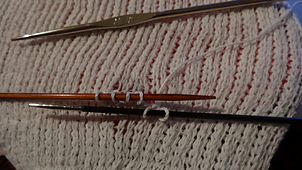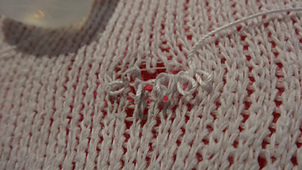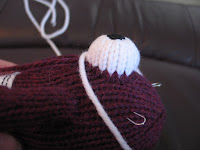Well I've been dragging along with my second llama. Not sure why overall as I was so looking forward to this adventure. Perhaps I made it a tedious challenge. I was just noticing this as I redid the face. Not sure if the current and final version is the fourth or sixth I've completed, but I'm feeling very sure about it and it is bound off.
The llamas body is only just started, but I improvised what it's going to look like with the body parts that I do have done. It will be far cuter when I get to the top of the head and the loops that match the colors on the face.

To visualize how the extra colors would look I sampled and painted colors over a snapshot of Frenchy, the first llama. I tried several versions and arrived at the last after realizing that the color that I'd thought was the darkest llama yarn I had wasn't the darkest after all. Following the coloring I saw on a llama called Macarena, I needed a lighter dark for the loops on the top of the head and a darker dark for the face color around the eyes. One of the most visible things my new llama is still lacking is a nose and mouth. (Well besides a completed body and also overlooking the fact that the eyes and eyelids are just pinned on.) For Frenchy I deliberately made her nose with curly nostrils because it seemed so many llama portraits showed sculptural nostrils. Lately I've been thinking she looks slightly melancholy, so I'm hoping to create a more joyful expression for my new llama.
 |
| A very early version of my color/stitch chart |
I needed a more precise model for figuring out the actual placement of color on the face, so I ultimately used blocking pins to frame where the color changes should be based on my colored photo and the coloring on the inspiration llama. I made a chart for myself based on this. I don't know that it's a type or method of chart that anyone else uses, but it made sense to me. I started with a hand drawn version of ovals arranged in a circle. Where I needed to make an increase I drew a line through the middle of an oval to make two stitches out of one. And on the next row there would be an additional stitch as a whole oval.

In the end I drew my chart in Illustrator. I had a variety of oval widths representing the stitches, but that's because each time a stitch was added in a row there would need to be an extra stitch in the next row, making the next row of ovals slightly narrower so they'd fit. If it weren't so blurry it would be clear how the white/snowball yarn is caught behind the dark yarn when I flipped the face over to purl back.























